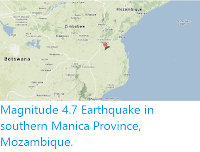Tropical Storm Ana is now thought to have killed 39 people on Madagascar, which it swept across on the weekend off 22-23 January 2022. The storm brought with it heavy rains, causing many rivers to burst their banks, with flooding being particularly severe around the island's capital, Antanarivo, where around 55 000 people are thought to have lost their homes.
The storm made landfall on the African mainland on Monday 24 January, in Nampula Province, Mozambique, and has caused severe flooding in the Zambezi River Basin in Mozambique, where at least three people have died in Zambezia Province, with 66 people injured and about half a million displaced by flooding across Zambezia, Nampula and Sofala provinces. In neighbouring Malawi, four people are reported to have died, with around 30 injured and many more displaced by flooding. Affected areas of both countries are suffering widespread power outages and are likely to run short on food and drinkable water rapidly.
Tropical storms are caused by solar energy heating the air above the oceans, which causes the air to rise leading to an inrush of air. If this happens over a large enough area the inrushing air will start to circulate, as the rotation of the Earth causes the winds closer to the equator to move eastwards compared to those further away (the Coriolis Effect). This leads to tropical storms rotating clockwise in the southern hemisphere and anticlockwise in the northern hemisphere. These storms tend to grow in strength as they move across the ocean and lose it as they pass over land (this is not completely true: many tropical storms peter out without reaching land due to wider atmospheric patterns), since the land tends to absorb solar energy while the sea reflects it.
Despite the obvious danger of winds of this speed, which can physically blow people, and other large objects, away as well as damaging buildings and uprooting trees, the real danger from these storms comes from the flooding they bring. Each drop millibar drop in air-pressure leads to an approximate 1 cm rise in sea level, with big tropical storms capable of causing a storm surge of several meters. This is always accompanied by heavy rainfall, since warm air over the ocean leads to evaporation of sea water, which is then carried with the storm. These combined often lead to catastrophic flooding in areas hit by tropical storms.
See also...



Follow Sciency Thoughts on Facebook.
Follow Sciency Thoughts on Twitter.













